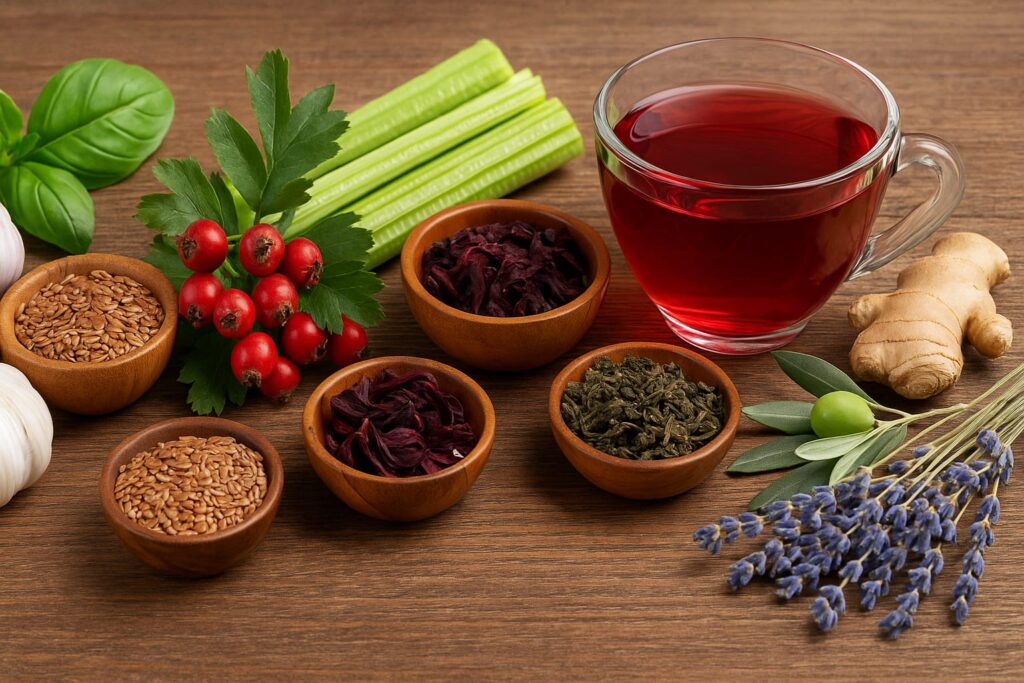Herbal Remedies for High Blood Pressure
High blood pressure, or hypertension, affects millions worldwide and remains a major risk factor for heart disease, stroke, and kidney failure. While medication can effectively manage it, many people turn to natural alternatives for additional support. Herbal Remedies for High Blood Pressure offer a gentle yet effective approach, often with fewer side effects. In this guide, we’ll explore the top herbs backed by science, how they work, and how to use them safely.

Herbal Remedies for High Blood Pressure: What Is High Blood Pressure?
Before diving into herbal solutions, it’s essential to understand the basics of high blood pressure. Blood pressure is the force of blood pushing against the walls of your arteries. A consistent reading above 130/80 mm Hg is considered high.
Over time, hypertension can damage arteries, reduce blood flow, and strain your heart. Therefore, addressing it early, ideally with a holistic approach, is critical.
Garlic As A Natural Blood Pressure Regulator
Garlic (Allium sativum) is perhaps the most studied of all herbal remedies for high blood pressure. It contains allicin, a sulfur compound that has been shown to reduce both systolic and diastolic pressure.
Garlic promotes vasodilation, widening of blood vessels, which reduces vascular resistance and improves circulation. Additionally, it may lower cholesterol and protect against oxidative stress.
How to Use It
- Raw garlic: 1-2 crushed cloves daily
- Aged garlic supplements: 600–1200 mg per day
- Garlic extract tincture: 1–2 ml, twice daily
However, those on blood thinners should consult a doctor before use.
Hawthorn: Heart Tonic with Historic Roots
Hawthorn (Crataegus species) has been used since ancient times to support heart health. Modern research confirms its ability to improve cardiovascular function and promote healthy blood circulation.
Hawthorn improves coronary blood flow and increases cardiac output, enhancing overall cardiovascular efficiency. Moreover, it contains flavonoids and oligomeric proanthocyanidins (OPCs), which reduce inflammation.
How to Use It
- Tincture: 1–2 ml three times a day
- Capsules: 250–500 mg standardized extract twice daily
- Tea: 1 tsp dried berries steeped for 15 minutes
It may take 4–8 weeks to see effects, but consistency is key.
Celery Seed as Herbal Remedies for High Blood Pressure: A Mild Diuretic
Celery seed (Apium graveolens) is more than a kitchen spice. It contains phthalides, which relax artery walls and enhance blood flow.
Some studies have shown that celery seed extract can significantly reduce blood pressure in people with mild to moderate hypertension.
How to Consume It
- Capsules: 75–150 mg twice daily
- Tea: Steep 1 tsp crushed seeds in hot water for 10 minutes
- Tincture: 1–2 ml twice daily
Because celery seed is a diuretic, it helps eliminate excess fluid, reducing pressure on arterial walls.
Olive Leaf: Mediterranean Medicine
Olive leaf extract is gaining recognition among herbal remedies for high blood pressure. It mimics the effects of some antihypertensive drugs, without the side effects.
The active compound, oleuropein, relaxes blood vessels and reduces vascular tension. It also boasts anti‑inflammatory and cholesterol‑lowering properties.
Dosage Guidelines
- Standardized extract: 500–1000 mg daily
- Tea: 1 tsp dried leaves per cup, steeped for 10 minutes
Therefore, use consistently for several weeks to assess full benefits.
Hibiscus: Delicious and Powerful
Hibiscus sabdariffa tea is not only refreshing but also widely appreciated for its ability to help lower elevated blood pressure naturally.
Several randomized trials have shown hibiscus tea can reduce systolic pressure by up to 10 mm Hg when consumed daily for 6 weeks.
How to Brew It
- Hibiscus tea: Steep 1–2 tsp dried petals in hot water for 10–15 minutes. Drink 2–3 cups per day.
- Extract capsules: 250–500 mg twice daily
Note: Avoid hibiscus if you are pregnant or have low blood pressure.
Rauwolfia: Potent but Requires Caution
Rauwolfia serpentina, also known as Indian snakeroot, is one of the most potent natural plants used to manage hypertension. Its key compound, reserpine, has even been incorporated into certain prescription medications due to its strong effects.
Although effective, it can have strong side effects like depression or fatigue. It’s typically used in low doses and under medical supervision.
How to Use It
- Capsules: Follow labeled instructions
- Tincture: 0.5–1 ml once daily
Always consult a qualified practitioner before use.
Lavender: Calming the Nervous System
Stress is a major contributor to hypertension. Lavender (Lavandula angustifolia) helps lower pressure by calming the nervous system.
Inhaling lavender essential oil or drinking lavender tea has been associated with reductions in blood pressure and heart rate.
Practical Applications
- Aromatherapy: Diffuse or inhale essential oil for 10 minutes
- Tea: 1 tsp dried flowers per cup, drink once daily
- Massage oil: Dilute essential oil with a carrier oil and apply to neck and temples
It’s especially helpful for stress‑related hypertension.
Valerian: Natural Sedative for Tension
Valerian root (Valeriana officinalis) is widely known for sleep, but also serves as a calming herbal remedy for high blood pressure.
By supporting GABA production in the brain, this herb helps to reduce anxiety, muscle tension, and blood pressure.
How to Take It
- Capsules: 300–600 mg before bed
- Tincture: 1–2 ml in water
- Tea: Steep 1 tsp dried root for 10 minutes
Avoid combining it with alcohol or sedative drugs.
Green Tea: Gentle Cardiovascular Support
Green tea is rich in catechins, which improve blood flow and reduce oxidative stress. While not the strongest, it’s a supportive herbal remedy for high blood pressure.
Suggested Use
- Tea: 2–3 cups daily
- Extract: 250–500 mg of EGCG per day
Although its effects may be mild compared to other herbs, consistent long-term use can significantly support vascular health and improve blood flow..
Herbal Remedies for High Blood Pressure: Lifestyle Tips to Enhance Herbal Support
Although herbal remedies for high blood pressure can help, they’re most effective when combined with lifestyle changes:
- Exercise: Aim for 30 minutes daily
- Diet: Emphasize fruits, vegetables, and low‑sodium meals
- Weight management: Even modest weight loss can reduce pressure
- Sleep: Aim for 7–8 hours nightly
- Stress reduction: Try meditation, yoga, or breathwork
Combining herbs with a healthy lifestyle provides the best long‑term outcomes.
Herbal Remedies for High Blood Pressure: Safety Considerations and Drug Interactions
Natural does not always mean safe. Many herbal remedies for high blood pressure can interact with medications, especially blood thinners, diuretics, or beta‑blockers.
Key Guidelines
- Always inform your doctor before starting herbal supplements
- Monitor your blood pressure regularly
- Start with one herb at a time to observe effects
Avoid self‑diagnosis or abrupt medication changes.
Herbal Remedies for High Blood Pressure: Final Thoughts
Herbs offer a powerful yet gentle approach to managing hypertension. Whether it’s garlic’s vascular benefits, hibiscus’s refreshing effect, or hawthorn’s heart toning abilities, there are numerous options available.
However, consistency is crucial. Always integrate herbs thoughtfully and with proper guidance. Over time, they can support your cardiovascular health naturally and effectively.
Herbal Remedies for High Blood Pressure – FAQ
Can herbs completely replace medication?
Not usually. Herbs can support and sometimes reduce the need for medication, but this should always be supervised by a healthcare provider.
How long before I see results?
Some herbs act within days (e.g., hibiscus), while others (like hawthorn) may take several weeks.
Are these remedies safe for pregnant women?
Most herbs, including hibiscus and rauwolfia, are not recommended during pregnancy. Always consult your doctor first.
